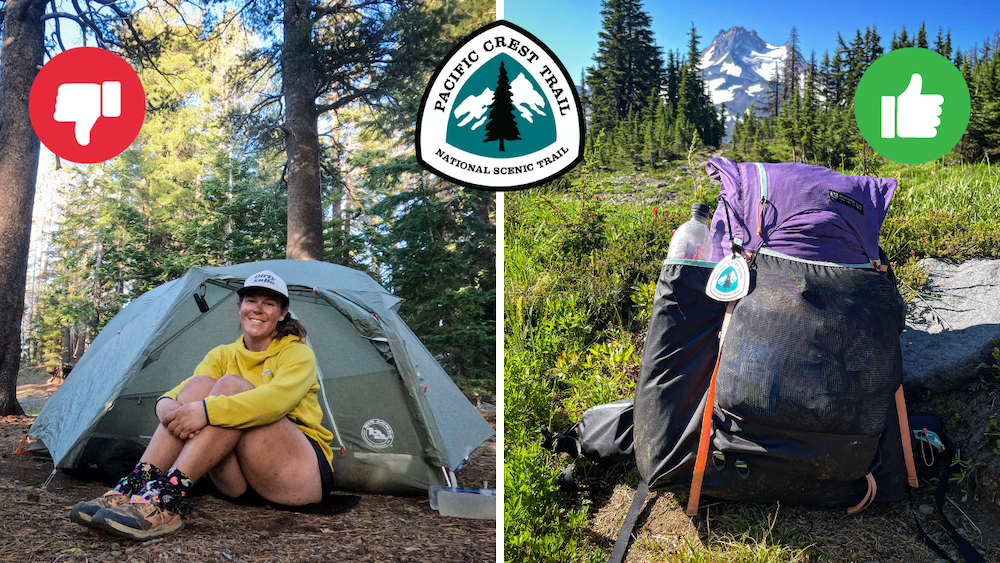
I get asked all the time about the backpacking gear I used on the Pacific Crest Trail this year for my solo, SoBo hike.
Questions like:
- What pack did I use?
- What tent did I use?
- What shoes did I wear?
- Is there anything I brought that I absolutely loved?
- Was there anything I hated?
- Did I make any gear changes during my hike?
I’m going to share with you my most favorite pieces of gear I used along the PCT this year – the gear I didn’t know I couldn’t live without.
I’m also going to share with you the worst gear – the gear I didn’t love so much, the gear that broke on me and needed to be replaced, sometimes multiple times.
My Pack
For my pack, I used the Gossamer Gear Mariposa 60 along my solo, southbound PCT hike this year and it was one of my most favorite pieces of gear. I have it in purple, which is also known as the Vaporwave color and style.
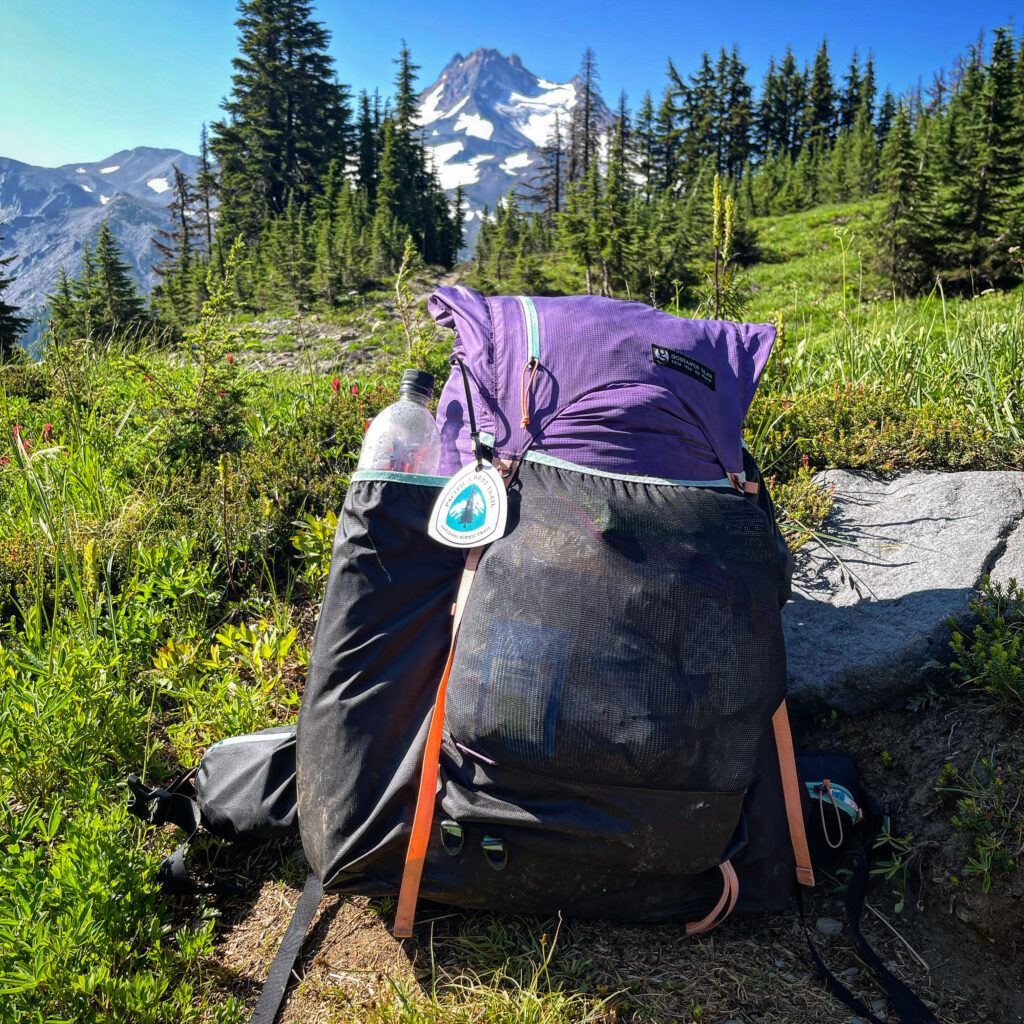
I love this pack! Why do I love this pack so much?
I never realized how important pockets were to me on pack until I discovered the Mariposa 60. This pack has 7 built-in pockets that makes packing and organizing super easy and efficient!
I use the big pocket on the side to store my tent poles, footprint for my tent and carry an extra liter of water in. On the other side, I use the bottom pocket to store my water filtration system for quick, easy access throughout the day. I use the top pocket to keep my poop kit in – another piece of gear I want quick and easy access to throughout the day.
In the back mesh pocket, I keep a bag full of the food I plan on eating during the day along with any wet gear or other gear I might need quick access to like my raincoat and/or a pair of microspikes.
On the hip belt, there are two spacious hip belt pockets, one on each side. This is where I store my knife, sunscreen, bug repellant, sunglasses, a pair of liner gloves and a buff.
On the inside of the pack, there’s a pocket for a hydration reservoir. I don’t use a hydration reservoir, but I did use this pocket to store my 11-inch iPad Pro with a foldable keyboard case, but more on that later.
On the top of the pack, there’s a zippered pocket, which I used to keep my PCT long-distance permit in for easy access whenever a ranger would ask to see my permit.
Besides all of the pockets, another reason why I love this pack so much is because it feels comfortable to wear when hiking 20+ mile days, even when it’s fully loaded with all of my gear. I also love how lightweight this pack is. The Gossamer Gear Mariposa 60 weighs in at just 2 pounds.
I also really love the color of my pack. Purple is my favorite color. If I could have all of my backpacking gear in purple, I would.
One change I made to this pack was that I replaced the SitLight Camp Seat that originally came with this pack with the Air Flow SitLight Camp Seat.
The Air Flow SitLight Camp Seat acts as extra padding along the back of my pack. It also allows air to circulate between my back and the pack while I’m wearing it, helping to keep my back from getting crazy sweaty while hiking throughout the day. It also makes for a comfy, lightweight butt pad whenever I stop to take a break out on trail.
In addition to the Mariposa 60, the Air Flow SitLight Camp Seat was another one of my favorite pieces of gear I used along the PCT this year.
My Tent
The Big Agnes Copper Spur 1-Person freestanding tent ended up being one of the worst pieces of gear I used during my PCT hike this year.
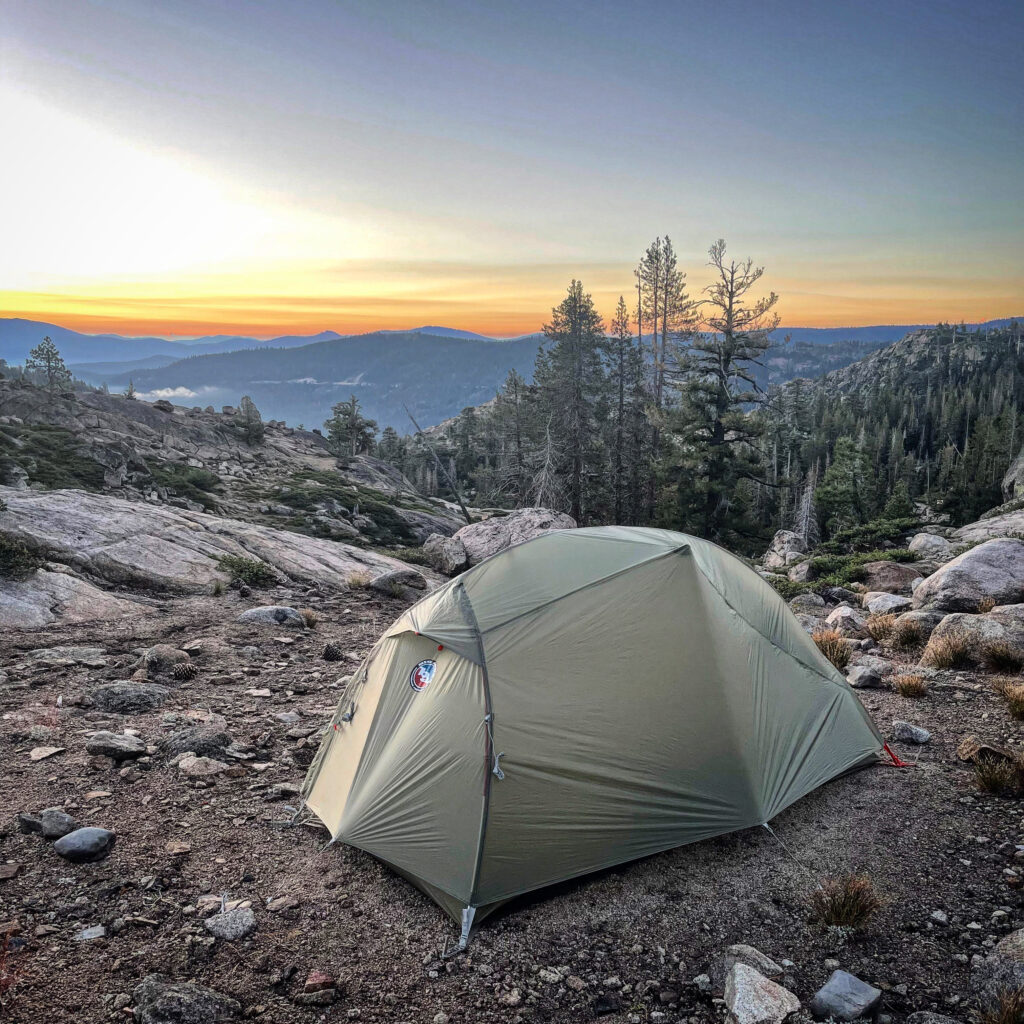
Why? The tentpoles ended up cracking on me, not one, but TWICE, causing me to have to go through three different tents along my hike this year.
Six days into my PCT hike, one of the poles cracked while I was setting up my tent. Luckily, I was less than a week from the nearest REI so I was able to exchange it for a new tent when I came into town in Bend, Oregon.
Less than two weeks after using my new tent, a different section of the tentpole cracked. This time I was much farther away from an REI and wouldn’t have the option to bring the tent in and exchange it for a new one. I did my best to do a temporary fix on the tentpole by using an emergency tent splint, but it wasn’t a great fix, and I knew it wouldn’t last long.
While out on trail, I reached out to Big Agnes via email to see if they could send me a new set of tentpoles since it was the tentpoles that had cracked, and the rest of the tent was fine. This ended up being kind of a disaster.
Big Agnes said they couldn’t send me a new set of tentpoles, but that they would send me a segment of the tentpole that I could then use to fix the broken section of the pole myself. The problem was once I gave them all of the detailed information about my tent…twice, they told me the soonest they could send the segment out on trail would be in 7-10 business days, which is basically two weeks when you’re hiking the PCT.
Two days later, when I had better cell service after coming into town, I called REI and asked them what my options were for getting a new tent. REI said they could send me a new tent in 4 days, which would be my next town stop – Chester, California. Once I received the new tent, I’d then need to send the tent with the cracked tentpoles back to REI.
This would’ve been great, except the tent REI tried sending me to Chester, California via General Delivery through the post office never arrived. In fact, I don’t think it ever shipped from REI. From Chester, I contacted REI to let them know that the tent hadn’t arrived when it was supposed to. REI apologized and told me that they would overnight me a new replacement tent to the hotel I was staying at, but this meant having to stay an extra two nights in town. I not only had to set hiking out of town back by two days, but I also had to financially cover an additional two-night hotel stay into my hiking budget in order to wait for the new tent to arrive.
Thankfully, the replacement tent from REI showed up at my hotel two days later, I was able to send the broken tent back to REI and got an easy hitch out of town and headed back out on trail.
The new Big Agnes tent and tentpoles from REI have been going strong ever since Chester, California. I was able to sleep in my new tent for the next month out on trail without any problems or cracked tentpoles.
After this experience though, I will never buy a Big Agnes tent again.
For $400, I would expect the tentpoles not to crack after using them for less than a month. And even if the tentpoles didn’t crack, I was REALLY disappointed with Big Agnes’s customer service and their inability to help me as quickly as REI did while I was out on trail.
Much love to REI though for helping me REPEATEDLY in my time of need along my PCT hike this year.
The Big Agnes Copper Spur 1-person tent is one of the worst pieces of gear for me this year. I guess that means I’m in the market for a new tent. Perhaps it’s time to try a trekking pole tent?
Water Filtration System
I made some BIG changes to my Water Filtration System this year. First, I switched to a Sawyer Squeeze water filter after using a BeFree filter over the last couple of years.
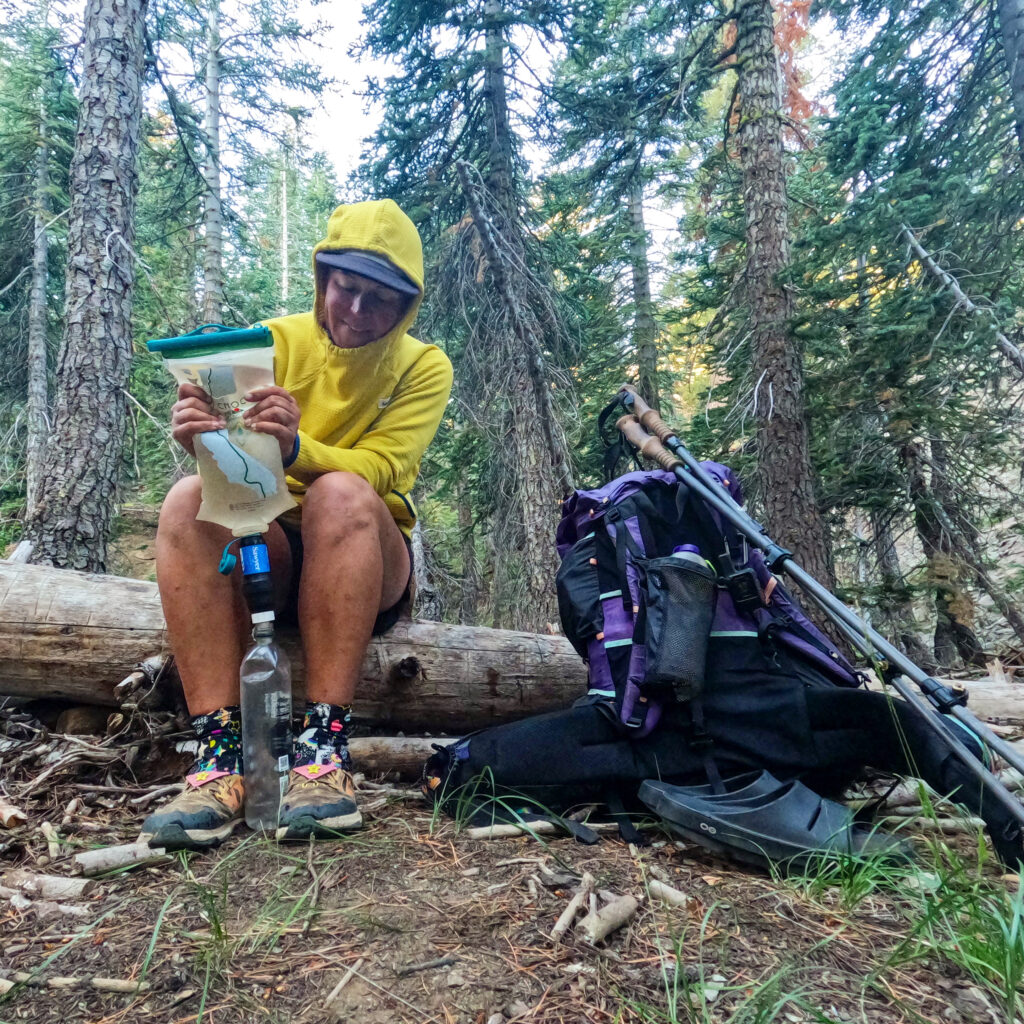
For my entire hike, my Sawyer Squeeze had a good flow to it, which made filtering water out on trail fast and easy. To ensure that my Sawyer Squeeze continued to have a good flow each time I filtered water, I made sure to backflush my filter every chance I got. Backflushing my water filter was just as much of an important town chore as it was to resupply my food and do my laundry.
Pro Tip: Make sure to back flush your water filter after every backpacking trip. If you’re doing a long-distance hike, make sure to back flush your filter every time you get into town.
Since I switched back to the Sawyer Squeeze, I also had to switch out my dirty water bag and collapsible drinking water bottle.
I used the CNOC Outdoors PCTA 2 liter Vecto bag, which has a map of the PCT on it. Honestly, put the PCT on anything and I’ll want to buy it. This bag was great, and I had zero issues with it along the trail this year.
I also switched my CNOC Outdoors collapsible water bottle to fit my Sawyer Squeeze filter and kept my water bottle easily accessible while hiking in a Chicken Tramper UG Shoulder Strap Sleeve that sat just below my right shoulder.
I absolutely loved my Water Filtration System out on trail this year. Each piece of gear in this system is considered a best piece of gear for me.
I also brought with me a collapsible travel water bottle to mix my breakfast smoothies and electrolytes in. I love this thing because it folds down next to nothing and has a wide opening, making it easier to clean out in-between uses. I also got a mini protein shaker ball to help mix up my electrolytes and smoothies even better.
It’s important to note that the collapsible travel water bottle is NOT critter proof. Make sure you store this one with your smelly and food items in either an Ursack or hard-sided bear canister. Sadly, on my last morning out on trail, I woke up to a critter chewing on my collapsible travel water bottle causing it to leak. I’ll be ordering another one from Amazon.
Foot Care
This year, I decided to bring a travel cork massage ball to use at camp for my feet. I’m so happy I did. In Oregon, when I was still getting my trail legs, my feet were really sore with hiking 20-25+ miles a day, climbing up and over blowdowns and traveling over dirt trail and lava rock. This little ball helped relieve a lot of pain and discomfort from my feet, both on my breaks and at camp at the end of the day.
Sometimes I’d wake up in the middle of the night and use my cork massage ball on my feet just to help them feel better. This was a piece of gear I ended up really loving and didn’t know how much I needed it until I started using it every day. And it conveniently fits in my hip belt pocket, making this even easier to use whenever I stopped for a break and needed to give my feet some relief.
Another piece of gear that turned out to be something I didn’t know I couldn’t live without were the unexpected camp shoes I purchased at REI in Bend, Oregon. I started my PCT hike this year without a pair of camp shoes because I wanted to save the weight and I didn’t think I’d need them. After hiking 140+ miles in Oregon, my feet were pretty beat up and sore. So I decided I needed a pair of camp shoes after all, just to give my feet some relief at the end of the day.
I picked up a pair of the OOFOS OOahh Slide Sandals from REI when I came in to exchange my tent in Bend, Oregon. They’re comfortable, lightweight and easy to pack on my pack – exactly how I wanted my camp shoes to be. They instantly made my life so much better whenever I took a break, got into camp at the end of the day and when I’d have to get out of the tent to go pee in the middle of the night. I even turned these into my town shoes and wore them exclusively as I made my way home from the trail this year.
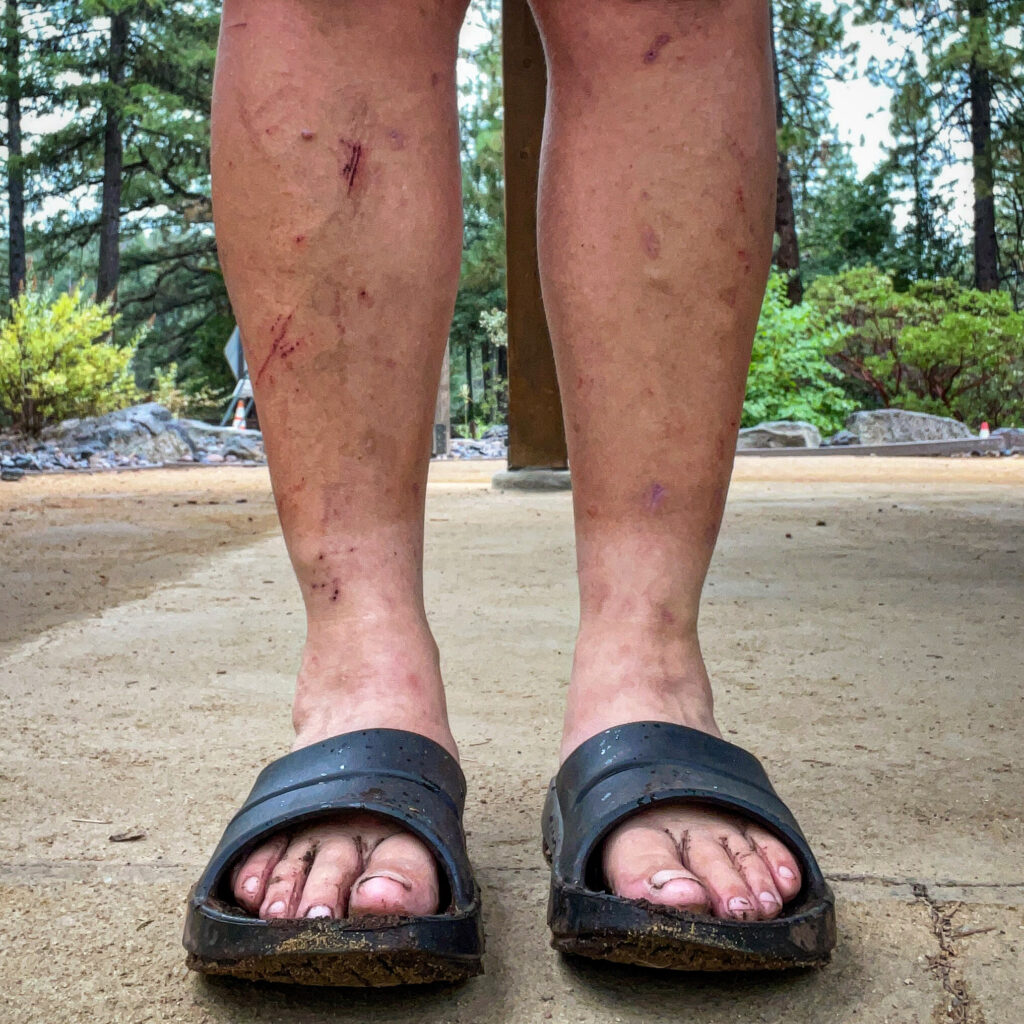
The OOahh Slide Sandals are a recovery slide, designed to help reduce stress on sore feet, knees and back. These foam shoes provide biomechanical support for sore feet. Kind of perfect for the long-distance hiker who hikes 20-25+ miles a day.
Because these sandals helped make my feet so happy for the rest of my PCT hike this year, they easily win the award for being one of my most favorite pieces of gear I didn’t know I needed and couldn’t live without.
I paid full price for my pair of OOFOS at REI in Bend, Oregon and they’ve honestly been worth every penny!
As for the shoes I hiked in this year, I decided to finally try a pair of the Altra Lone Peaks. I started my PCT hike this year wearing a pair of 6s and replaced them with a brand-new pair of Altra Lone Peak 7s from REI when I went into Bend, Oregon.
I’m so happy I finally decided to make the switch to Altras! These shoes are incredibly comfortable, they dry really fast, and my toes have plenty of room to expand in the extra roomy toe box. I also love how they have the already attached Velcro piece on the back of the shoe, making it super easy to attach a pair of gaiters.
My gaiters of choice this year were the Ultra Gam Gaiters in the rainbows and unicorn print, another favorite piece of gear for me this year. One piece of gear that didn’t work for my feet were the Superfeet Hike Support Insoles. These, paired with my Altra Lone Peak 6s caused a lot of pain and discomfort to my feet during the first 140+ miles along the PCT this year. Once I switched to a new pair of Altra Lone Peaks and ditched the Superfeet insoles, the pain in my feet subsided quite a bit.
Even though I ended up not loving the Superfeet insoles, it doesn’t mean that they’re a bad piece of gear. Theses insoles just didn’t work for my feet with the shoe I was hiking in.
Portawipes
Portawipes ended up being one of my most favorite pieces of gear out on trail this year. Instead of using baby wipes, which are pretty heavy and bulky, I brought Portawipes to use as toilet paper and also to give myself a wipe bath at camp at the end of the night. They’re small, lightweight and compact. To use, all you need to do is add a little water and it turns into a moist towel you can use to clean up with.
Pro Tip: After boiling water for dinner, I’d leave a little extra warm water in my pot and then add a couple Portawipes. This way, my Portawipes would be nice and warm for my wipe bath. They felt amazing to use when wiping off my face.
Here’s a little plug for LNT – Leave No Trace. Remember, whatever you pack in, you must pack out. Please don’t bury used Portawipes. Just like with toilet paper, baby wipes and any other trash you create when out on trail, pack out any used Portawipes with your trash.
Bug Repellant System
While hiking through Oregon along the PCT this summer, I needed to make sure my bug repellant system game was STRONG. There were quite a few pockets of bug swarms, but I experienced a majority of the bug drama for a 100-mile stretch, from Elk Lake Resort all the way to Summit Lake.
Instead of using bug repellant spray with 100% Deet, like I’ve always used, I wanted to try using lightweight insect repellant wipes. They’re much lighter than the spray and there less likely to leak on the gear inside my pack. I started off by using insect repellant wipes paired with wearing my bug net through the really buggy sections on trail, but the wipes just weren’t really cutting it. I was getting covered with bug bites.
Another hiker suggested I try using Sawyer Picaridin Insect Repellant Lotion. So when I went into Bend, Oregon for a town day, I picked up a bottle from REI.
This lotion is amazing!
Since it’s a lotion, it went on my skin smooth, didn’t smell weird and didn’t make my skin feel dry and itchy like the bug spray did. I also didn’t have to worry about it leaking on any of my gear. Since I was applying a generous layer of this stuff each morning before getting out of my tent, I kept the bottle stored in one of my hip belt pockets for easy access throughout the day.
This stuff is pretty long lasting. I only had to reapply once a day, if I was sweating a lot. It’s also Deet-free and worked exceptionally well with helping to keep the bugs away from me while I was hiking and sitting at camp in shorts. This lotion paired with my bug net was a HUGE gear win for me this year.
Satellite Messenger
Earlier this year, I upgraded my Garmin inReach Explorer+ to a Garmin inReach Mini 2. Not only is the Mini 2 much smaller and lighter than my old Explorer+ (I can hardly feel it sitting on the shoulder strap of my pack), but it has new technology built into it, there’s more battery life, it’s durable and fairly easy to use.
You can use the device itself to access key features, but if you want a bigger screen than the screen on the device, you can also use the Garmin Explore app on your cellphone to navigate through the device.
I used my Garmin inReach Mini every single day I was out on the PCT this year.
Before I started hiking for the day, I’d turn on my device, start tracking and send a pre-set message to friends and family at home letting them know I was starting my day. I also used my Garmin Mini to check the current weather forecast for any specific location I was at and message friends and family throughout the day. Luckily, I never had to use the SOS button, but it was nice to know I had the option just in case I needed to.
This device isn’t cheap, and it does require a monthly subscription for it to be functional, but the price of the device and monthly subscription is worth every penny to me.
The Garmin Mini gives me and my friends and family at home peace of mind whenever I’m out on trail hiking solo. This is why my Garmin inReach Mini 2 is one of my most favorite pieces of gear and the piece of gear I was I would’ve invested in sooner.
Power Bank
This year, I upgraded my power bank to a smaller, lightweight and more powerful Nitecore Carbo 20000 Power Bank. I’ve carried a few different power banks along my long-distance backpacking trips and this power bank is hands down, my most favorite one I’ve used so far.
This 20000mAh power bank has one USB-A port and USB-C port available for fast charging. It also has the ability to charge two devices at the same time. I was able to keep my iPhone and Mini 2 fully charged while out on trail in-between towns, for up to 5-6 days at a time. I never once ran out of battery life.
I love how small and light this power bank is. It can easily fit into my fanny pack or any one of my hip belt pockets and it weighs a little under 11 ounces.
Some other cool features on the Nitecore Carbo 20000 Power Bank:
- It’s lightweight and weighs a little under 11 ounces
- It can easily fit into my fanny pack or any one of my hip belt pockets.
- There’s a battery level indicator with 4 LED pin lights on the power bank, which shows how much battery life is left on the power bank.
- It’s rated IPX5 water resistant, which means it can withstand light splashes of water and withstand moist, humid environments.
- Thanks to its carbon fiber shell, it’s also rated 1.5 meter impact resistant, making this a pretty durable device to use when out on trail.
iPad
At the beginning of my PCT hike this year, I thought it might be a good idea to bring with me an iPad that I could use to stay in touch each week with students in my online backpacking program for women, The Confident Solo Female Backpacker System and to edit videos for my YouTube channel whenever I was in town.
So I brought with me an 11-inch iPad Pro with a foldable keyboard case.
This ended up being a bad idea.
There was nothing wrong with the iPad itself and I loved the convenience of having a foldable keyboard case. The problem was this thing was HEAVY! The iPad, foldable keyboard case and exterior, padded case were almost two pounds AND I had to carry the charging cord for it as well.
While on trail, I kept the iPad stored inside my pack in the hydration reservoir pocket, so that it would sit along my spine. I was always worried about it getting wet whenever I got caught in a rainstorm out on trail and I cursed the iPad every time I hiked uphill. It was more weight I wanted to carry for a piece of gear I’d only use while I was in town.
I thought about sending the iPad up ahead to myself on trail via USPS so I didn’t have to carry it with me while hiking, but I didn’t want to risk losing it in the mail. Plus, once I got into town, I usually found myself way too tired to even think about editing a YouTube video.
After carrying the iPad with me all the way to Chester, California for 593 miles and only editing two videos for my YouTube Channel, I decided to send my iPad back home.
Fleece Layers
The final piece of gear I want to mention is my Fayettechill Leah hoodie and Sage pants.
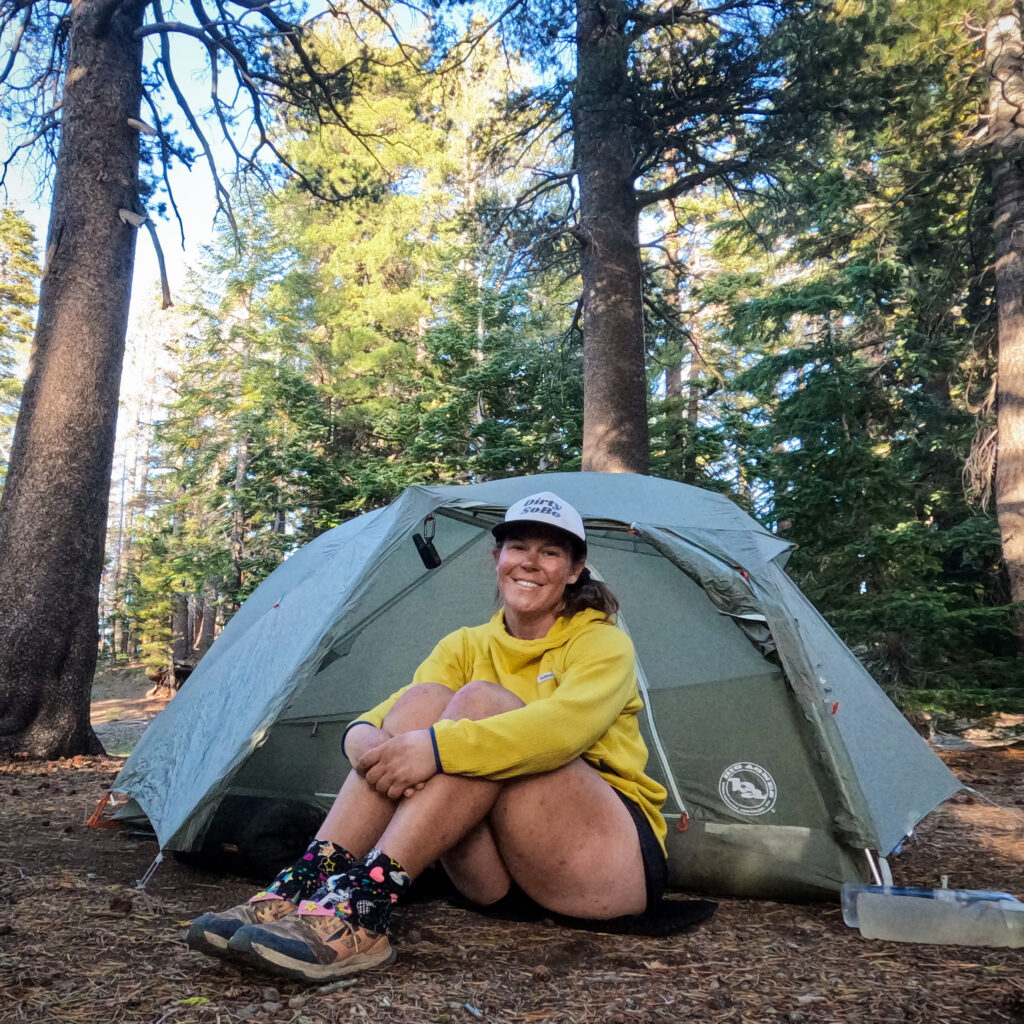
When I first started my PCT hike this year back in July at the Washington/Oregon border, it was HOT. Even though I had packed the hoodie and pair of pants to potentially sleep in, I couldn’t imagine putting either one of them on because it was so hot out. After hiking 45 miles on the PCT and reaching Timberline Lodge near Mount Hood, I sent home my Fayettechill Sage pants, but kept the hoodie. I wanted to make sure I always had an insulating layer for when I was at camp and whenever I was in town.
I LOVE my Fayettechill Leah hoodie. It’s lightweight, breathable, is super comfortable, has a roomy hood that fits easily over my hiking hat and is made of moisture wicking Polartec Power Grid material, which helps keep me dry whenever I start sweating underneath. Plus, the yellow color is really bright and fun to wear. Having gear in fun colors can be a mood lifter on those really tough days out on trail.
Get 10% off your Fayettechill order + FREE Shipping by using promo code, HUNGRYHIKER10
By the time I reached Kennedy Meadows North, 860 miles later, my Fayettechill Sage fleece pants were waiting for me. I was ready to layer up the clothing I wore out on trail for the upcoming Sierra section. I was happy to have these pants to wear each at camp because it got pretty cold, pretty quickly once I stopped hiking for the day.
So these were my most favorite pieces of gear I used along my PCT hike this year AND the gear I didn’t love so much.
If you want to see the complete list of all the gear I brought with me for my PCT hike this year, check out this video where I break down all of my gear in detail, by system, including my Pack System, Shelter System, Sleep System, Cooking System, Water Filtration System, Repair/Tool/Toiletry Kit, First Aid Kit, Poop Kit, Misc Gear, Electronics, Packed Clothes and the Clothes I Hiked In.
For more details about each of the items mentioned in this video including weight and links to where you can find each item online, check out my 2023 PCT SoBo Thru-Hike Backpacking Gear List.
Disclaimer: The-Hungry-Hiker.com is a participant in the Amazon Affiliate Links and AvantlInks Program, affiliate advertising programs designed to provide a means for sites to earn advertising fees by advertising and linking to Amazon.com and other affiliated sites at no cost to you. Please note, I only link to products and services I personally use and trust.

2 Comments on Best & Worst Backpacking Gear I Used This Year